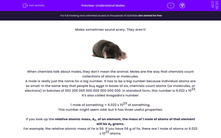Moles sometimes sound scary. They aren't!

When chemists talk about moles, they don't mean the animal. Moles are the way that chemists count collections of atoms or molecules.
A mole is really just the name for a big number. It has to be a big number because individual atoms are so small. In the same way that people buy eggs in boxes of six, chemists count atoms (or molecules, or electrons) in batches of 602 200 000 000 000 000 000 000. In standard form, this number is 6.022 x 1023. It's also called Avagadro's number:
1 mole of something = 6.022 x 1023 of something.
This number might seem odd, but it has three useful properties:
If you look up the relative atomic mass, Ar, of an element, the mass of 1 mole of atoms of that element will be Ar grams.
For example, the relative atomic mass of Fe is 56. If you have 56 g of Fe, there are 1 mole of atoms or 6.022 x 1023 atoms.
If you work out the relative formula mass, Mr, of a substance, the mass of 1 mole of that substance will be Mr grams.
For example, water is H2O, so its relative formula mass, Mr = (2 x 1) + 16 = 18.
If you have 18 g water, there are 1 mole of water molecules, or 6.022 x 1023 molecules.
If you have 1 mole of gas molecules at room temperature and pressure, their volume will be 24 000 cm3 (or 24 litres).
This works whatever the gas is.
Converting between mass and moles
The equation for this is: number of moles = real mass in g ÷ relative formula mass
For example, how many moles are there in 12 g of sodium hydroxide, NaOH?
1. Work out the relative formula mass: Mr = 23 + 16 + 1 = 40.
2. Substitute into the equation: number of moles = 12 ÷ 40 = 0.3.
Using moles in reaction equations
Moles are a good way to think about the ratios in chemical reactions. For example, sodium hydroxide reacts with hydrochloric acid to make sodium chloride + water:
NaOH (aq) + HCl (aq) → NaCl (aq) + H2O (l)
Suppose we have 12 g of sodium hydroxide. We've already worked out that is 0.3 moles of NaOH. According to the reaction equation, 1 mole of NaOH, plus 1 mole of HCl react to make 1 mole of NaCl, plus 1 mole of water. So if we have 0.3 moles of NaOH, we have 0.3 moles of everything else.
The formula mass of NaCl = 23 + 35.5 = 58.5, so 1 mole of NaCl is 58.5 g.
Therefore, the mass of NaCl made is 0.3 x 58.5 g = 17.55 g.
You don't have to do this problem using moles - you can work out the ratios from scratch each time. But it's harder that way.
The reason moles are useful is because they give the ratio a name, which makes it easier to think about.
Let's try some questions now.







